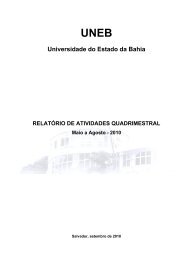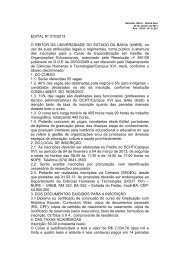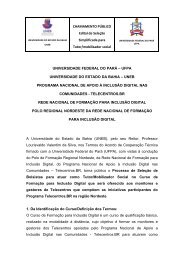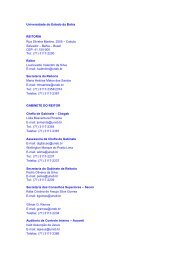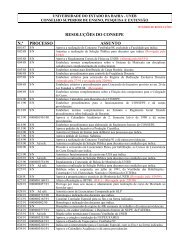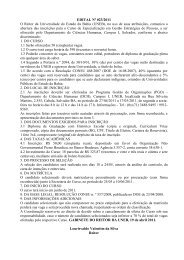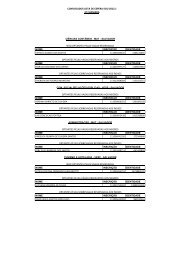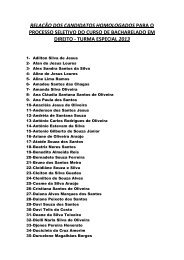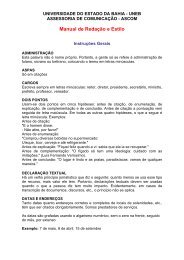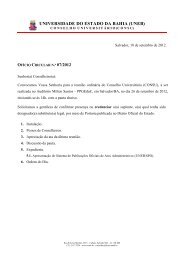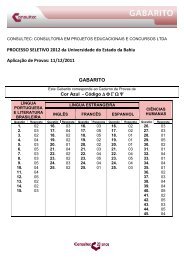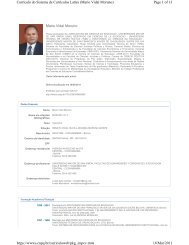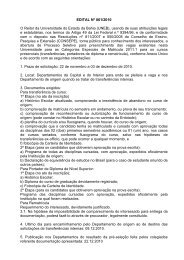Revista da FAEEBA Educação e Contemporaneidade - Uneb
Revista da FAEEBA Educação e Contemporaneidade - Uneb
Revista da FAEEBA Educação e Contemporaneidade - Uneb
Create successful ePaper yourself
Turn your PDF publications into a flip-book with our unique Google optimized e-Paper software.
In search of América: latina/os (re)constructing the U.S.A.<br />
ge linguistic enclaves with German-language<br />
instruction in public schools. In 1880, four of<br />
every five students of German descent in St.<br />
Louis, for example, attended bilingual schools<br />
(SURO, 2004). Germans by World War I were<br />
economically and socially integrated into the<br />
U.S. Only the extreme anti-German sentiments<br />
of the war era led them to abandon their language<br />
and oftentimes their very names.<br />
Unfortunately for the nation, given the need<br />
in a globalized economy for speakers of other<br />
languages, Latina/os do not appear to be retaining<br />
their language significantly better than earlier<br />
groups. The 2002 National Survey of Latina/<br />
os found that among second-generation adults,<br />
only seven percent relied on Spanish as the<br />
primary language. Half had no Spanish skills at<br />
all, and the rest were bilingual. Learning English<br />
is considered essential; eighty-six percent<br />
strongly agreed in the National Council of La<br />
Raza Survey (2004) that “The ability to speak<br />
English is important to succeed in this country,”<br />
and 84 percent agree that “The government<br />
should support and expand the numbers of programs<br />
to help immigrants learn English.” Hispanics<br />
also recognize the need to come together<br />
themselves if change is to occur; eighty-eight<br />
percent agreed that “It is important for the Hispanic<br />
community to work together to build political<br />
power.”<br />
Toward New Paradigms<br />
Past models for understanding the immigrant<br />
experience are no longer viable for many of<br />
to<strong>da</strong>y’s newcomers, who are better conceptualized<br />
as “transnationals.” The globalization that<br />
has proceeded apace in recent decades has set<br />
millions of people around the world into motion,<br />
as neoliberal policies displace peoples and First<br />
World countries hold out some meager measure<br />
of hope to the dispossessed. One could argue<br />
that what the U.S. is witnessing is a “harvest<br />
of empire” (GONZALEZ, 2000). U.S. actions<br />
have helped put in place policies and people that<br />
promoted inequalities in its hemispheric neighbors<br />
and ultimately economic instability that dri-<br />
252<br />
ves immigration (as with other colonial powers).<br />
Mexican workers who moved at the whim of<br />
U.S. government needs, and Puerto Ricans<br />
shuttling back and forth between the Island and<br />
mainland in search of survival were perhaps the<br />
earliest transnationals. They are now joined by<br />
a multitude of people who hold multiple allegiances<br />
that straddle physical borders.<br />
Transnational identities cross over territorial<br />
boun<strong>da</strong>ries and national culture in ways that are<br />
difficult to grasp from a traditional ethnographic<br />
perspective (APPADURAI, 1991, 1990). Recent<br />
approaches to transnational communities have<br />
begun by discarding the conventional image of<br />
immigration as a form of cultural stripping away<br />
and complete absorption into the host society<br />
(ROSALDO, 1989). Rather, immigrants belong to<br />
multiple communities with fluid and hybrid<br />
identities that are not necessarily grounded in<br />
geopolitical frontiers but perhaps in subjective<br />
affiliations. Border crossing becomes an apt image<br />
for not just the physical act of moving to another<br />
country but also the crossover between cultures,<br />
languages, and nation-states in which transnational<br />
migrants participate. (DUANY, 1994, p.2)<br />
Older notions of the nation-state, of impermeable<br />
borders, and citizenship must be rethought<br />
in the current era when one of every hundred<br />
people around the world are living in a country<br />
other than their country of birth (FRITZ, 1998).<br />
Latinos are deeply insinuated into the fabric of<br />
this new globalized world as transnational networks<br />
and communities continue to expand.<br />
Sixty-one percent of Mexicans have a relative<br />
currently residing in the United States, and remittances<br />
from abroad are Mexico’s third-largest<br />
source of income (THOMPSON, 2002).<br />
The number of Latin American countries allowing<br />
dual citizenship jumped in the 1990s from<br />
four to ten, including Mexico in 1998. U.S. Latinos<br />
with dual citizenship are voting in federal<br />
elections in their home countries, or even running<br />
for elected office. Regardless of whether<br />
people hold dual citizenship, they retain connections<br />
to their homelands; remittances from the<br />
U.S. to the Dominican Republic for instance<br />
grew from 25 million dollars in 1970 to almost<br />
800 million dollars in 1995 (VÉLEZ-IBÁNEZ<br />
and SAMPAIO, 2002).<br />
<strong>Revista</strong> <strong>da</strong> <strong>FAEEBA</strong> – <strong>Educação</strong> e Contemporanei<strong>da</strong>de, Salvador, v. 15, n. 25, p. 239-257, jan./jun., 2006



